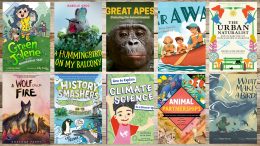We’ve found some fantastic new books to stimulate your kids’ curiosity about nature and the environment during the upcoming summer break. Many of these books can be shared by the whole family and complement your vacation destination — or your exploration of local parks and trails.
The writers and illustrators of these books — all published in the first six months of 2025 —embrace the environment and include delightful explorations of the world, with a good dose of ecology and other science sprinkled in.
We’ve excerpted the books’ official descriptions below. As always, the links go to the publishers’ sites, but you can also find these books through your local bookstore or library.
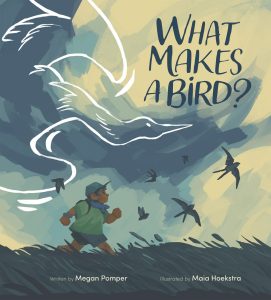
Written by Megan Pomper and illustrated by Maia Hoekstra
Children 4-10
In this evocative picture book, a child wanders through nature with one question: What makes a bird a bird? Is it feathers? The beak? Could it be wings? With each possible answer, more questions arise and expand a child’s awareness. If laying eggs makes a bird a bird, what about other egg-laying creatures like turtles, snakes, or fish? With gorgeous illustrations and subtle STEM content, this thoughtful picture book invites readers to think about what makes us human and how we categorize and identify the world around us.
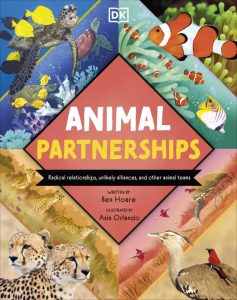
Animal Partnerships: Radical Relationships, Unlikely Alliances, and Other Animal Teams
Written by Ben Hoare and illustrated by Asia Orlando
Children 7-9
Get acquainted with unexpected animal teams around the world and find out how these groups thrive in the wild as they defend, feed, and plot with each other in order to survive in this fascinating and unique look at animals.
Presenting these unpredictable discoveries, Ben Hoare’s friendly, informative explanations are paired with striking photographs and colorful illustrations to make sure every page captivates the imagination.

The Urban Naturalist: How to Make the City Your Scientific Playground
By Menno Schilthuizen
Teens and Up
Thanks to the open science revolution, real biological discoveries can now be made by anyone right where they live. This book shows readers how to go about making those discoveries, introduces the tools of the trade of the urban community scientist, from the tried and tested (the field notebook, the butterfly net, and the hand lens) to the newfangled (internet resources, low-tech gadgets, and off-the-shelf gizmos). But beyond technology, his book holds the promise of reviving the lost tradition of the citizen scientist, rekindling the spirit of the Victorian naturalist for the modern world.
At a time when the only nature most people get to see is urban, The Urban Naturalist demonstrates that understanding the novel ecosystems around us is our best hope for appreciating and protecting biodiversity.
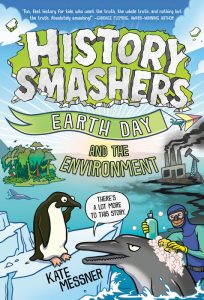
History Smashers: Earth Day and the Environment
By Kate Messner
Children 8-12
It’s true that the first Earth Day encouraged people around the globe to clean up their act when it came to the environment. But activists have been working for centuries to save the planet! Native people across the world developed sustainable farming practices, women in eighteenth-century India stood up to protect trees, and amateur scientist Eunice Foote discovered the science behind global warming all the way back in the 1850s! Join the History Smashers team to bust history’s biggest misconceptions and figure out what in the world really went down before (and after!) the first Earth Day — and how you can join the fight to protect the environment.
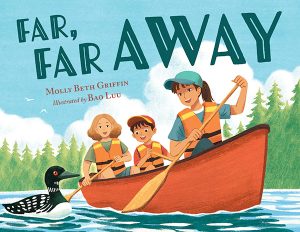
Written by Molly Beth Griffin and illustrated by Bau Luu
Children 2-8
Mom and Mama are taking Rowan on his first camping trip, far away from the city where they live. Rowan is excited to see all kinds of wildlife, maybe even a bear or a moose! But canoe camping is hard work. Before long, Rowan is tired and hungry, itchy from mosquito bites, and downright grumpy. In fact, he wants to go home. Mom and Mama listen to his complaints and show him something truly special that they don’t have at home, something that makes Rowan glad they worked so hard to go far, far away, where the wilderness is really wild.

Great Apes: Protecting Our Animal Cousins
By Christopher Gudgeon
Children 8-12
Get to know our charismatic chimpanzee cousins, the peaceful bonobos, three types of high-flying orangutans, and those gentle giants of the jungle, the gorillas. Discover where and how they live, their biology, what they eat and what they share in common with humans ― beyond their opposable thumbs. These giant mammals are our closest relatives in the animal world, known for their intelligence, complex social structures and communication skills. But great apes everywhere are in trouble. Their habitat is being destroyed by deforestation and the effects of climate change. Their population is dropping, and fast. In Great Apes, find out what conservationists, scientists and young people all over the world are doing to protect them.
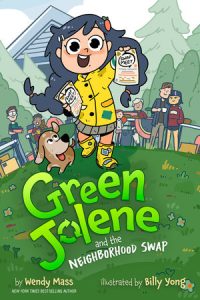
Green Jolene and the Neighborhood Swap
Written by Wendy Mass and illustrated by Billy Yong
Children 8-12
Jolene wouldn’t have guessed that the first day of summer vacation would start with her trying to figure out if the squishy object smelling up her backpack was a half-eaten tuna sandwich or a six-month-old plum! (It was both!) While dumping old food in the trash and bringing out the recycling, Jolene sees the huge boxes of stuff her new neighbors got delivered. She realizes how many of her own belongings she doesn’t use anymore.
Horrified by the idea of contributing to overflowing landfills and trash-filled oceans, Jolene hatches a big plan to not only deal with her own stuff, but her whole neighborhood’s unwanted items as well. Clad in her favorite rain boots, Jolene is ready to save the world. Or, at least, to tackle her own neighborhood’s stuff and find some surprising new allies along the way.

How to Explain Climate Science to a Grown-Up
Written by Ruth Spiro and illustrated by Teresa Martínez
Children 8-12
The best-selling author of the Baby Loves Science series levels up with this playful STEM picture book introducing kids (and grown-ups) to climate science.
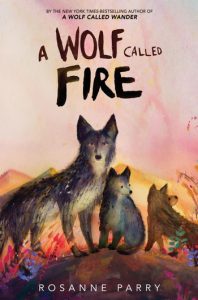
A Wolf Called Fire: A Voice of the Wilderness Novel
By Rosanne Parry
Children 8-12
Inspired by Wolf 8, a real Yellowstone wolf who was the smallest of his pack and constantly bullied by his bigger brothers. Wolf 8 survived a tumultuous first year and grew up to be a different sort of leader — one who fought many rival wolves to submission but never killed any. He had a rare talent for mentoring young wolves and became the patriarch of the largest and most successful pack in Yellowstone by choosing a more collaborative and generous leadership style.
Written and photographed by Isabelle Groc
Children 6-8
Noah’s family has just moved into a new apartment on the 22nd floor when an Anna’s hummingbird visits their balcony. Soon the young boy notices a fuzzy nest being built — like Noah’s family, this hummingbird is making a new home. This true story shows the hummingbird through Noah’s eyes as he discovers how these birds feed, care for, and raise their young. Alongside Noah’s story are facts explaining where Anna’s hummingbirds live, their role as pollinators and the threats they face from pollution, pesticides, urban predators and a warming climate. Readers will learn that with a few simple actions, we can all help hummingbirds survive and thrive in urban areas.
Enjoy these summer reads wherever you spend your summer days — and at whatever age.
Let us know what you think. Send your ideas, success stories, and other book recommendations to [email protected]
For hundreds of additional environmental books — including many more for kids of all ages — visit the Revelator Reads archives.
Previously in The Revelator:
Comics for Earth: Eight New Graphic Novels About Saving the Planet and Celebrating Wildlife

